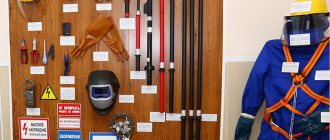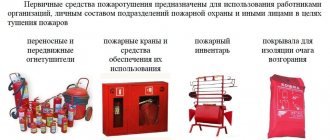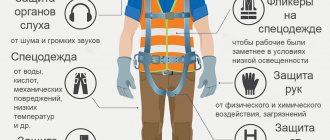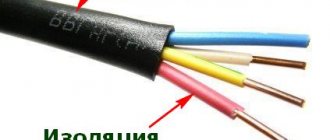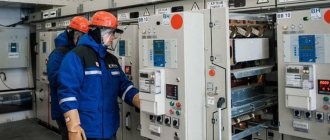What is PPE: decoding and definition
PPE stands for “personal protective equipment.” These are means used by the employee to prevent or reduce exposure to harmful and dangerous production factors, as well as to protect against pollution. They are used in cases where work safety cannot be ensured in any other way (for example, by the design of equipment, organization of production processes, architectural and planning solutions and collective protective equipment).
PPE may include special clothing, special footwear, isolation suits, respiratory protection, hand protection, head protection, face protection, hearing protection, eye protection, and various safety devices.
The relationship between PPE and special assessment of working conditions
The results of the assessment of working conditions (WSA) are used to resolve the issue of using protective equipment. This is justified by Order of the Ministry of Labor No. 976-n dated December 5, 2014.
After carrying out the special operational assessment, the employer may be required to replace PPE, provide, purchase additional equipment or bring the issued equipment into proper condition.
What violations may there be on the part of the employer?
Common violations of company management:
- purchase using employee funds;
- purchasing products that do not have certificates and quality standards;
- deterioration of available funds;
- repairs and replacements are not carried out on time.
Types of personal protective equipment (PPE)
According to GOST 12.4.011-89 “System of occupational safety standards (SSBT). Protective equipment for workers. General requirements and classification” personal protective equipment, depending on the purpose, is divided into 12 classes:
- insulating suits (pneumatic suits, waterproofing suits, spacesuits);
- respiratory protection equipment (gas masks, respirators, self-rescuers, pneumatic helmets, pneumatic masks, pneumatic jackets);
- special protective clothing (sheep coats, coats, short coats, short fur coats, capes, raincoats, half-coats, dressing gowns, suits, jackets, shirts, trousers, shorts, overalls, bib overalls, vests, dresses, sundresses, blouses, skirts, aprons, shoulder pads);
- foot protection (boots, boots with an extended top, boots with a short top, ankle boots, boots, low shoes, shoes, shoe covers, galoshes, boots, slippers (sandals), high boots, boots, shin guards, over the knee boots, knee pads, foot wraps);
- hand protection (mittens, gloves, semi-gloves, finger pads, palm pads, wrist pads, sleeve pads, elbow pads);
- head protection (hard hats, helmets, balaclavas, caps, berets, hats, caps, headscarves, mosquito nets);
- face protection equipment (face shields);
- eye protection (goggles);
- hearing protection equipment (anti-noise helmets, anti-noise earplugs, anti-noise headphones);
- fall protection equipment and other safety equipment (safety belts, cables, hand grips, manipulators, knee pads, elbow pads, shoulder pads);
- dermatological protective products (protective creams, skin cleansers, reparative agents);
- complex protective equipment.
Personal protective equipment is also classified depending on the influencing factors:
- protection from mechanical damage;
- protection from industrial pollution;
- protection against watery solutions;
- protection against non-toxic dust;
- protection against toxins and other chemical compounds;
- protection from biological factors (viruses, microbes);
- radiation protection;
- protection from electrical influence;
- protection when working in low visibility areas.
Legislative framework of the Russian Federation
Free legal aid hotline
- Encyclopedia of mortgages
- Codes
- Laws
- Document forms
- Free consultation
- Legal encyclopedia
- News
- about the project
Free consultation
Navigation
Federal legislation
- Constitution
- Codes
- Laws
Actions
- home
- ORDER of the Ministry of Energy of the Russian Federation dated June 30, 2003 N 261 “ON APPROVAL OF INSTRUCTIONS FOR THE APPLICATION AND TESTING OF PROTECTION MEANS USED IN ELECTRICAL INSTALLATIONS”
Appendix 8. STANDARDS FOR PROTECTIVE EQUIPMENT
| Name of protective equipment | Quantity |
| Switchgears with voltages above 1000 V | |
| Insulating rod (operational or universal) | 2 pcs. for each voltage class |
| Voltage indicator | Same |
| Insulating pliers (in the absence of a universal rod) | 1 PC. for each voltage class (with appropriate fuses) |
| Dielectric gloves | At least 2 pairs |
| Dielectric boots (for outdoor switchgear) | 1 pair |
| Portable grounding | At least 2 for each voltage class |
| Protective fences (shields) | At least 2 pcs. |
| Safety posters and signs (portable) | According to local conditions |
| Insulating gas mask | 2 pcs. |
| Protective shields or glasses | 2 pcs. |
| Electrical installations with voltage 330 kV and above (optional) | |
| Individual shielding kits | According to local conditions, but not less than 1 |
| Shielding devices | According to local conditions |
| Switchgears with voltage up to 1000 V | |
| Insulating rod (operational or universal) | According to local conditions |
| Voltage indicator | 2 pcs. |
| Insulating pliers | 1 PC. |
| Dielectric gloves | Two pairs |
| Dielectric galoshes | Two pairs |
| Dielectric carpet or insulating pad | According to local conditions |
| Safety barriers, isolation pads, portable posters and safety signs | Same |
| Protective shields or glasses | 1 PC. |
| Portable grounding | According to local conditions |
| Transformer substations and distribution points of power distribution networks 6 - 20 kV (except package transformer substations, switchgear and mast substations) | |
| Insulating rod (operational or universal) | 1 PC. |
| Dielectric carpet or insulating pad | According to local conditions |
| Switchboards and control panels of power plants and substations, rooms (workplaces) of electricians on duty | |
| Voltage indicator | 1 PC. for each voltage class above 1000 V and 2 pcs. for voltage up to 1000 V |
| Insulating clamps for voltages above 1000 V (in the absence of a universal rod) | 1 PC. for each voltage class above 1000 V (with appropriate fuses) |
| Insulating clamps for voltages up to 1000 V | 1 PC. |
| Clamp meter | According to local conditions |
| Dielectric gloves | Two pairs |
| Dielectric galoshes | Two pairs |
| Insulating tool | 1 kit |
| Portable grounding | According to local conditions |
| Dielectric carpets and insulating pads | Same |
| Safety posters and signs (portable) | Same |
| Safety helmets | 1 PC. for every worker |
| Protective shields or glasses | 2 pcs. |
| Respirators | 2 pcs. |
| Operational field teams servicing substations and power distribution networks | |
| Insulating rods (operational or universal) | 1 PC. for each voltage class |
| Voltage indicators up to and above 1000 V | 2 pcs. for each voltage class |
| Individual voltage alarms | 1 PC. for every employee working on overhead lines |
| Insulating clamps for voltages above 1000 V (in the absence of a universal rod) | 1 PC. for each voltage class (with appropriate fuses) |
| Insulating clamps for voltages up to 1000 V | According to local conditions |
| Dielectric gloves | At least 2 pairs |
| Dielectric boots (for outdoor switchgear) | Two pairs |
| Insulating tool | 1 kit |
| Electrical clamps for voltages up to and above 1000 V | According to local conditions |
| Portable grounding | According to local conditions, but not less than 2 pcs. |
| Dielectric carpets and insulating pads | According to local conditions |
| Protective shields or glasses | 2 pcs. |
| Safety posters and signs (portable) | According to local conditions |
| Voltage indicator for checking phase coincidence | Same |
| Safety helmets | 1 PC. for every worker |
| Respirators | According to local conditions |
| Safety belt | Same |
| Operational maintenance team for substations, overhead and cable lines | |
| Insulating rods (operational or universal, measuring) | 1 PC. for each voltage class |
| Voltage indicator above 1000 V | 1 PC. for each voltage class |
| Voltage indicator up to 1000 V | 2 pcs. |
| Individual voltage detector | 1 PC. for every employee working on overhead lines |
| Portable grounding | According to local conditions, but not less than 2 pcs. |
| Voltage indicator for checking phase coincidence | According to local conditions |
| Dielectric gloves | At least 2 pairs |
| Dielectric bots | 1 pair |
| Safety belts and safety ropes | According to local conditions |
| Protective shields or glasses | Two pairs |
| Protective shield for electric welder | 1 PC. |
| Insulating tool | 2 sets |
| Dielectric carpets and insulating pads | According to local conditions |
| Safety posters and signs (portable) | Same |
| Respirators | Same |
| Safety helmets | 1 PC. for every worker |
| Mobile high-voltage laboratories | |
| Voltage indicator up to and above 1000 V | 1 PC. for each voltage class |
| Insulating rod (operational) | Same |
| Dielectric gloves | Two pairs |
| Dielectric bots | 1 pair |
| Safety poster set | 1 |
| Dielectric carpet | At least 1 |
| Safety helmets | 1 PC. for every worker |
Notes 1. Acquisition standards are minimum and mandatory. Technical managers and workers responsible for electrical facilities are given the right, depending on local conditions, to increase the number and expand the range of protective equipment.
2. When placing RU equipment up to and above 1000 V on different floors or in several rooms separated from each other by doors or other rooms, the specified number of protective equipment applies to the entire RU as a whole.
3. RUs of the same voltage, with no more than four in number, located within the same building and serviced by the same personnel, can be provided with one set of protective equipment, excluding protective fences and portable grounding.
4. Mast-mounted substations, package transformer substations and switchgear switchgear are equipped with protective equipment according to local conditions.
Requirements for personal protective equipment
Here are the basic requirements for PPE according to GOST 12.4.011-89:
- Protective equipment for workers must ensure the prevention or reduction of hazardous and harmful production factors. The PPE itself should not be a source of hazardous and harmful production factors.
- Protective equipment must meet the requirements of technical aesthetics and ergonomics.
- The choice of a specific type of protective equipment for workers should be made taking into account the safety requirements for a given process or type of work.
- PPE should not change its properties during washing, dry cleaning and disinfection.
- Personal protective equipment must be assessed for protective, physiological, hygienic and performance indicators.
- Requirements for labeling personal protective equipment must comply with GOST 12.4.115 and labeling standards for specific types of personal protective equipment.
- Personal protective equipment must have instructions indicating the purpose and service life of the product, the rules for its operation and storage.
Employer's obligations in terms of provision
Providing workers with PPE is the main function of the company’s occupational safety and health service.
The procedure for providing workers with personal protective equipment
The company's management, in the process of fulfilling its obligations to employees, is obliged to comply with labor protection requirements within the professional activities of personnel. For this purpose, the company creates local documents, acts, orders, which reflect the safety regulations. The text of such documents always contains a reference to the tools and devices used that employees should receive.
Important! Management's responsibilities include issuing the required products, training employees in the basic rules of their use, maintaining records of issuance, carrying out repairs, cleaning and replacement, and proper storage.
The types of PPE required in the workplace for specific positions are determined by management in consultation with employees or their representatives. The correct selection of protective equipment should be preceded by the collection and analysis of information related to the future use of these equipment in the workplace.
